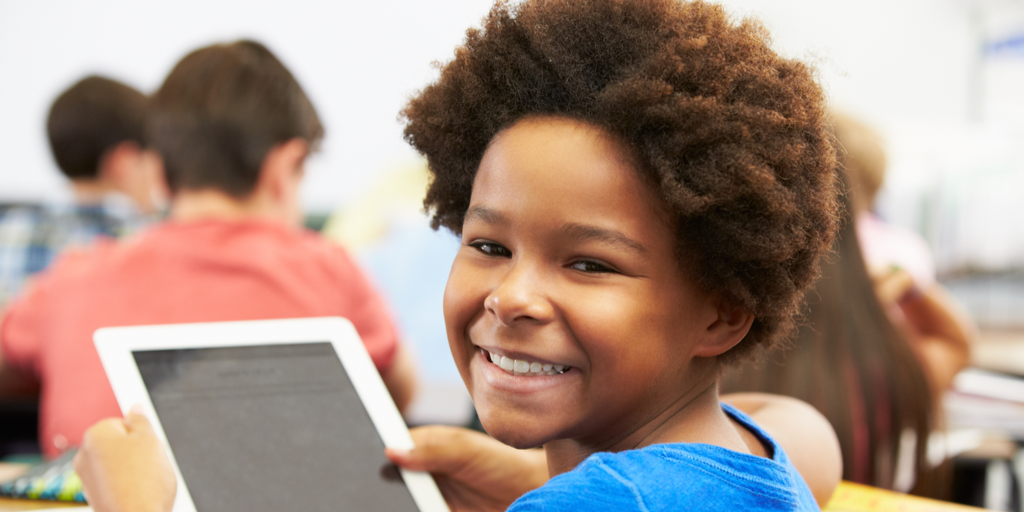Educators Blog
Versatile Tools for Blended Learning
By Rachelle Dené Poth,
Sometimes it is fun and beneficial to try unconventional tools or methods, to immerse students more in learning and do things differently than what they have become accustomed to. Making a change to the traditional style and structure of the classroom can feel uncomfortable at first, but giving students more control in designing their learning is worth it. The flexibility of these tools enables learning to happen anywhere and at any time, based on the student’s or school schedule, which helps to foster a blended learning environment. Here are a few ideas to immerse
Augmented/Virtual Reality
One of the biggest areas of growth in education has been the use of Augmented and Virtual Reality in the classroom. In my own classroom, we have used a variety of tools and students have enjoyed the time exploring new tools and definitely different ways to learn. The idea of teaching by using tools for AR or VR can seem challenging, but it really can be quite simple to add it to the course and there are tons of resources available. I recommend exploring the resources shared by Jaime Donally on all things related to Augmented and Virtual Reality in education.
These tools can offer more powerful ways to immerse students in learning, to “travel” and “explore” places and things more closely. Students can create, problem solve, become more curious and experience something unique through the use of these tools, which enable learning to happen beyond the classroom walls and involve students in more collaborative experiences.
Tools to try:
- 3DBear: A newer platform that enables students to add objects
into their space and then narrate a story in augmented reality. Teachers are able to create a class account and can choose from the lessons available for grades 1-6 and up, in content areas including ELA, Math, Social Studies, Science, and also STEAM-related topics. Each lesson includes links to reading materials, timelines, and also worksheets. Teachers can sign up for a free trial. - CoSpaces: A tool for creating “spaces” where students can tell a story and create a game to represent their learning in a more authentic and meaningful way. Students can work together on projects and design a more immersive story together. Working together helps students to develop their digital citizenship skills as well as promote social-emotional learning skills. An engaging way to reinforce content is by having students design spaces they can then “walk” through in virtual reality.
- Metaverse: An augmented reality tool that teachers can use to create assessments with or have students design an interactive “experience” full of choices in characters, GIFS, 360 images, themed objects, and more. There are “experiences” available and it is easy to get started by watching the tutorial videos from Metaverse. Students can create their own experiences and share them with classmates and teachers can create more engaging review activities for students.
- Shapes 3D Geometry: An app that gives students and teachers a more interactive way to explore core concepts of geometry and that can help students discover 2D and 3D shapes in an augmented reality experience. Using a Merge cube, students can examine 3D shapes by holding the solids in their hands, manipulating them, and being able to more closely understand the core concepts of geometry.
Learning Beyond the Classroom: Virtual Field Trips
It is important for students to experience learning and explore the world, beyond the limits of the classroom time and space. While we can't easily take students to faraway places, there are different tools that make these “trips” possible. The right tools bring in a world of learning for our students, enabling them to closely look at a location rather than by simply watching videos or looking at pictures in a book. We can even connect students with other classrooms and experts around the world by using one of these options in our classes. Many of these tools are easy to get started with and some even have lessons available, which makes the lack of time factor, not an issue.
Tools to Try:
- Google Expeditions: By using Google Expeditions, teachers can “guide” students in faraway lands or have them closely view an object in Augmented reality. All that is required is the App, and then students need to be on the same wifi as teachers in order to “explore” in the classroom. Teachers can choose from more than 100 objects in augmented reality and 800 virtual tours to travel around the world. Each tour includes a script with guiding questions and enrichment activities, all easily accessible by downloading them to a device.
- Skype: Years ago, connecting with other classrooms took a lot of time to plan, work with different schedules, and access to the right technology. Now through tools like Skype, students,
and teachers can connect with anyone in the world. By joining the Microsoft community, teachers can connect with other classrooms and create connections for students to communicate by using Skype, or for more fun and pushing critical thinking, collaboration, and problem-solving skills, try using Mystery Skype.
Tools for Anywhere Learning
With blended learning, students have the online component as well as the traditional in-class instruction. One type of blended learning involves the use of stations. By using some of these tools, especially if access to devices is an issue, students can participate in station rotations and learn in multiple ways. The best part is that these tools are accessible when convenient for students as well.
- Nearpod: A favorite because it is such a versatile tool that offers a lot of options for how to have students interact with the content, and even go on virtual reality tours and explore 3D shapes. Some of the activities you can include are polls,
open-ended responses, matching pairs, and content such as BBC videos, PhET simulations, and more recently, a Desmos graphing calculator. A tool to enhance instruction whether in or out of the classroom and one which students can use to create their own lessons to share. - Buncee: Students can create multimedia presentations that include a variety of items such as animations, emojis, 360 images, and web content including videos that can be embedded
into the presentation. Teachers can create a lesson using Buncee by adding videos, audio, hyperlinks, and sharing one link with students, which leads to multiple other activities. - Quizizz: A game-based learning tool that can be used for instruction, both in and out of class or for students to create their own games as more authentic practice. Quizizz has thousands of games available in the library and recently added a student log-in that enables students to track their progress and gives them access to prior games played so they can always go back and review. Having this available to students makes it more personalized because students can get extra practice whenever they need it.
- Kahoot!: Challenges with Kahoot have become quite popular. Teachers can “challenge” students to participate in a game as a way to practice the content or review for an assessment. Students can even challenge each other by sharing games and codes, which makes it good for peer collaboration and building
social-emotional learning skills. - Synth: A podcasting tool that can be used to have students respond to questions, and participate in a conversation by responding to a prompt or a “thread.” A thread is a string of responses in a conversation. Creating with Synth is easy and simply by recording a prompt that can also include a video, teachers can promote communication and student discussion beyond the school day. Teachers can then listen to all student responses as a podcast.
Finding new tools to explore is always fun, especially when we have students create with them and share their work with classmates. We learn more about their interests and needs and they have a more personalized experience.
These tools have
About the Author:
Rachelle Dene Poth has been teaching at Riverview High School in Pennsylvania for the past 21 years. Rachelle currently teaches Spanish and a STEAM course What’s nExT? In Emerging Technology. Rachelle is an attorney and has a Master’s Degree in Instructional Technology. She was President-Elect of the Teacher Education Network and Communications Chair for the Mobile Learning Network and was selected as one of “20 to watch” by the NSBA and received the PAECT Outstanding Teacher of the Year for 2017. At ISTE 2017 San Antonio, Rachelle received the Presidential Silver Award for Volunteer Service to Education. She is a regular blogger for Getting Smart and Kidblog. Find Rachelle regularly on Twitter @Rdene915.
Subscribe to the #1 PBL Blog!
Receive new articles in the world of Project Based Learning, STEM/STEAM, and College & Career Readiness.

